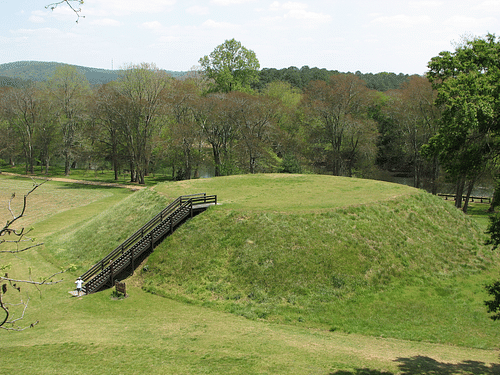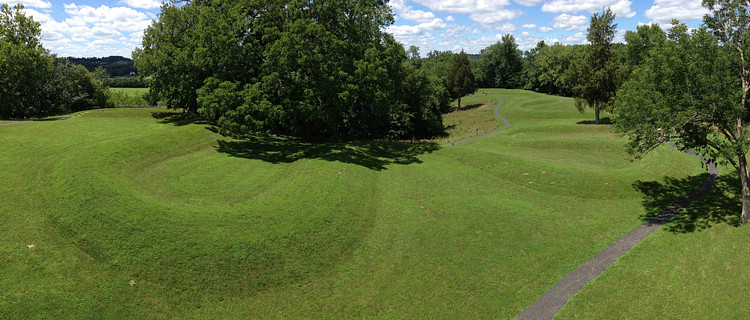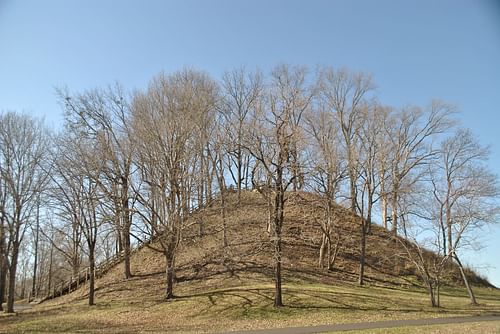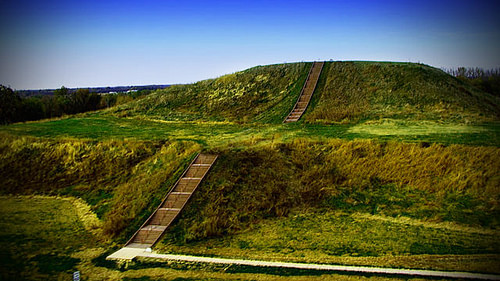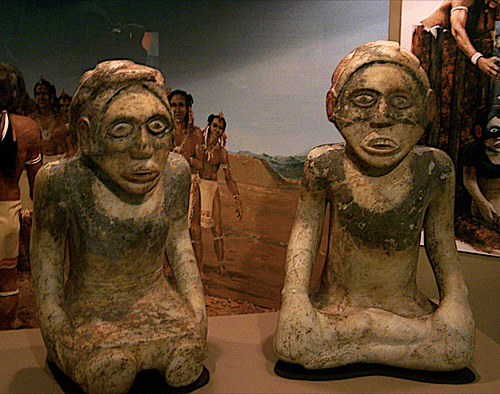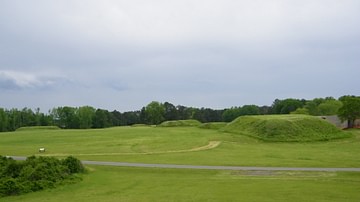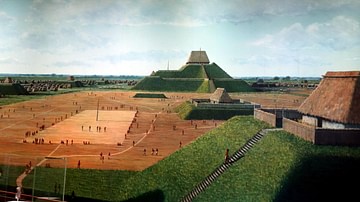The Native Americans of Pre-Colonial North America built thousands of mounds across the continent which served various purposes and sometimes reached heights over 100 feet. Many of the mound sites were thriving urban centers – such as Cahokia in Illinois – while others seem to have served strictly religious/ritualistic purposes, as in the case of Pinson Mounds in Tennessee.
European settlers, not knowing what the mounds were and periodically mistaking them for naturally formed hills, destroyed many out of ignorance while others were purposefully eliminated to make room for town and city expansions and still more were looted for treasures to be sold on the antiquities market and severely damaged or demolished in that way. Even when it was understood that these mounds were significant paragons of ancient native architecture, landowners still destroyed them to prevent the state or other agencies from trying to take their land in the interests of preservation.
In the present, there are still many mound sites extant throughout the United States, some protected as archaeological parks, others on private lands, and every one of them offers a different insight into the cultures of the different Native American Nations that built them. A little-known site such as Man Mound in Wisconsin is just as important as one better known such as Serpent Mound in Ohio. The following list necessarily leaves out many important sites but those selected have been chosen for the type they represent and their contribution to a better understanding of Native American cultures.
Time Periods & Locations
The mounds were built from c. 5000 BCE up through the period of European colonization which is usually given, in this case, as c. 1540 CE when the Spanish conquistador Hernando de Soto (l. c. 1500-1542) traveled with his army through the regions of present-day Florida, Georgia, and Mississippi – all of which had mound sites - searching for gold and the De Soto expedition records natives living on or near these large mounds. De Soto killed a number of natives when they would not hand over the gold he insisted they were hiding but did more damage in spreading European diseases the natives had no immunity to. When later European explorers reached the region, the natives there had no idea who had built the mounds because their elders, who kept the history of the nation alive through oral tradition, had long ago died. The ten sites presented below which exemplify this tradition are:
- Watson Brake (Louisiana, c. 3500 BCE)
- Poverty Point (Louisiana, c. 1700-1100 BCE)
- Serpent Mound (Ohio, built either c. 320 BCE or c. 1000-1750 CE)
- Effigy Mounds (Iowa, c. 500 BCE-1000 CE)
- Pinson Mounds (Tennessee, c. 1-200 CE)
- Observatory Hill Mounds (Wisconsin, c. 500-1200 CE)
- Cahokia (Illinois, c. 600-c. 1350 CE)
- Etowah (Georgia, c. 1000-1550 CE)
- Moundville (Alabama, c. 1100-c. 1450 CE)
- Spiro Mounds (Oklahoma, c. 900-1450 CE)
It was not until the 19th century that the descendants of the early European immigrants took an interest in the mounds and, at that time, they refused to believe they were built by Native Americans who were considered “too simple” to have managed such an enormous undertaking. Even though scholars and intellectuals of the 18th and 19th centuries recognized the mounds as “native in origin”, that claim was not widely accepted until the mid-20th century.
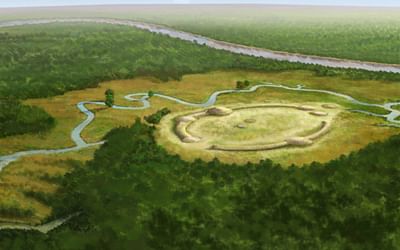
It is now understood that different Native American cultures created the mounds at different times, using similar methods, beginning in the Archaic Period (c. 8000-7900 BCE), continuing through the Woodland Period (c. 500 BCE-1100 CE), and on into the period of the Mississippian Culture (c. 1100-1540 CE). The mounds are all characterized, no matter what their original purpose, by a high degree of technical skill in engineering, evidence of a large labor force, and some sort of central authority directing logistics, supply, and construction.
Watson Brake
The oldest extant mound site in North America is Watson Brake in northeast Louisiana. The site includes eleven mounds connected by ridges and was built during the Archaic Period around 3500 BCE (making it older than the Great Pyramid of Giza, dated to the reign of King Khufu, 2589-2566 BCE). The site was built and occupied by a hunter-gatherer culture who also created tools and ceramics and lived by fishing the Ouachita River and its tributaries. The purpose of the mounds is unclear as they were not used for burial, residences, or ritualistic ceremonies. The site was only discovered in the 1980’s by a local resident, Reca Bamburg Jones, after timber was cleared from the land and they became visible. Part of the site was purchased only as recently as 1996 by the Archaeological Conservancy but another section is still owned by the family who has held it since the 1950’s who refuse to sell or allow public access but have allowed professional excavations.
Poverty Point
Poverty Point takes its name from the 19th century plantation of one Phillip Guier who farmed the land the mounds are on without realizing the “hills” were artificial constructs. No one understood this, in fact, until 1953 when an aerial photograph showed the small “hills” were six C-shaped ridges built facing a central plaza with six larger mounds placed around the ridges. The site was recognized as early as the 1830’s as a Native American “village” based on artifacts found there but the ridges and mounds were considered natural formations. The ridges were created in stages over a number of generations and were used for residential purposes (homes built on top) while the mounds were built quickly (Mound A in under three months) and served other purposes, including religious rituals. The focal point of the site is the plaza where there was a solar calendar of wooden posts and rituals were most likely also observed. The so-called Poverty Point Culture that built the site were also hunter-gatherers and, like those of Watson Brake, created tools and artifacts but there is more evidence of long-distance trade at this site than the earlier one.
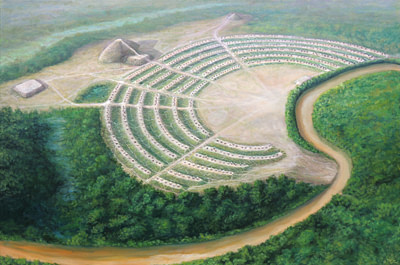
Serpent Mound
Serpent Mound is a 1,346-foot-long (411 meters) earthen representation of a serpent built on a leveled plateau. Archaeologists are still uncertain of its date as it was originally thought to be a product of the Adena Culture (c. 800 BCE-1 CE) but later was claimed to have been built by the Fort Ancient Culture (c. 1000-1750 CE). The site contains no artifacts to conclusively link it to either and it is possible it was begun by the earlier and finished by the latter, both of whom lived in the region and created other mound structures. Carbon dating of charcoal found in the mound dates at least one section to 1070 CE which some scholars claim definitively dates the whole to that period as they believe it was created to mirror Halley’s Comet which appeared in 1066 CE and was observable from this point for enough time to make an impression. The head of the “serpent” aligns to the summer solstice while the coils align with the winter solstice sunrise and equinoxes. There is no doubt it was constructed for astronomical purposes but who built it continues to be debated.
Effigy Mounds
Effigy Mounds derives its name from the shape of the mounds which either fully represent or feature earthen effigies of bears, birds, and other animals. The mounds are attributed to a number of Native American nations working over many generations although some of the over 200 mounds show evidence of fairly quick construction. The site is one of the largest in North America with the most varied types of mounds. The best-known, Great Bear Mound, is 137 feet long and 70 feet wide, depicting a series of bears in a line. The mounds are thought to have been primarily ceremonial (although some were used for burial) and the animal symbols represented the totemic forces associated with the given nations that worked on the site.
Pinson Mounds
Pinson Mounds is thought to have been built and used for religious/ceremonial purposes entirely as there is no evidence of permanent habitation, only an area adjacent to the mounds for temporary residence, such as one would expect to find at a pilgrimage site. Although 30 mounds were recorded there in the early 20th century, a number of these turned out to be natural formations and the site in the present day features 15 mounds. The largest is Sauls Mound (named for the property owner John Sauls) which is 72 feet (22 m) high. Some mounds show evidence of burials but, overall, they appear to have been used for religious purposes by the people of the Woodland Period, possibly the ancestors of the Chickasaw Nation who owned the lands in the 19th century. Ozier Mound, the second largest at the site, has been positively identified for use in rituals while some other mounds were used for burial and the purpose of still others is unknown.
Observatory Hill Mounds
There were once at least five mounds on present-day Observatory Hill (on the campus of University of Wisconsin-Madison) of which two remain today – one in the shape of a large bird and the other known as the two-tailed water spirit. The other mounds were destroyed between 1900-1922 when the university was enlarging its campus and it is certain that a Native American village or city was once located at the site based on artifacts discovered there and earlier reports. The extant mounds, like those at Effigy, are thought to represent totemic energies associated with the builders; the bird effigy channeling air and wind and the two-tailed spirit, the gift of water. Without the context of the other mounds, however, these mounds are difficult to interpret.
Cahokia Mounds
Cahokia Mounds is the best-known mound site in the United States and among the most impressive. Cahokia is named for the tribe that lived near the site in the 19th century CE, the original name is unknown, but between c. 600-c.1350 CE, the city was the largest urban center on the continent of North America and engaged in long-distance trade in every direction. It is thought the city developed in response to a call by the priest-class for people to participate in building Monks Mound, the tallest at the site requiring 814,000 cubic yards of earth and rising to a height of 100 feet (30 m). Of the 120 mounds built, 80 survive in the present day and were once part of a complex that also featured ball courts, a large plaza, a solar calendar (known now as Woodhenge, 48 wooden posts encircling a central post), residential and commercial districts, and fields of various crops. The cultivation of corn encouraged the growth of the city which used the surplus in trade. The artifacts and tools so far excavated at the site show a high level of sophistication which is mirrored in the engineering skill evidenced by the construction of the mounds.
Etowah Mounds
The Etowah Mounds were built in three stages during the period of the Mississippian Culture and, presently, six of these are extant. Three platform mounds seem to have been used for ritualistic purposes and the smaller mounds for residences. Mound A is 63 feet (19 m) high with a base of 3 acres. Temples with courtyards topped the mounds which surrounded a central plaza used for commercial purposes and a ball court for the game known as Chunkey. The whole city was surrounded by a wooden palisade with watchtowers spaced 80 feet (2 m) apart suggesting the people lived in fear of invasion and conquest by other indigenous nations. This observation is supported by grave goods which include both ceremonial and everyday weaponry. The site is best known for the discovery of paired male-female statues depicting a cross-legged seated man and kneeling woman thought to represent the spirits of the peoples’ ancestors and most likely used in religious rituals.
Moundville
Moundville is the second largest such site in the USA after Cahokia featuring 28 platform mounds, once topped by residences, facing a plaza with a central mound (Mound A) rising 58 feet (18 m) with two ramps up alternate sides. The elite and nobility lived in homes on the mounds while the lower classes lived across the plaza in thatched huts. The architecture of the site is believed to reflect social stratification in literally elevating the upper class on artificial mountains above the others. Mound A is positioned with a direct view of the nearby Black Warrior River, suggesting that observances conducted there honored the four elements of water, air, fire (the sun), and earth. Like many of these mound sites, Moundville’s original name is lost and, also like the others, it was abandoned prior to the time of European colonization; this was most likely due to overpopulation and depletion of resources.
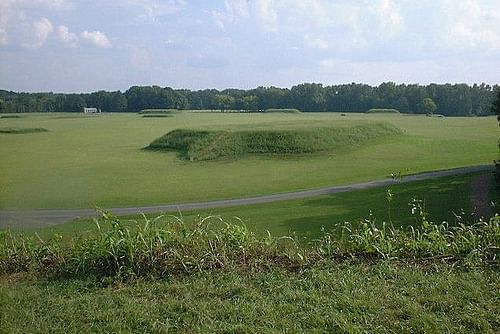
Spiro Mounds
The Spiro Mounds, 12 of which are extant today, were constructed in four phases and completed prior to c. 1250 CE. Nine of the mounds surround a central plaza with a larger mound (Brown Mound) in the center which served a religious/ceremonial purpose. These ceremonies seem to have centered on the funerary rituals of the community leaders and members of the clergy (who were often, though not always, the same). The two other extant mounds (Craig Mound and The Great Mortuary) were used for burial and had internal cavities built purposefully for the preservation of various artifacts such as feather bonnets and headdresses, fur and feather coats, and statuary of wood or copper, as well as other pieces. Craig Mound was looted and partially destroyed between 1933-1935 by a group who purchased temporary rights from the landowner to excavate and then, when they had finished, purposefully blew up the central chamber of the mound for unknown reasons. Artifacts looted at that time have largely been lost to the antiquities market. Population declined at the site between c. 1250-c.1450 CE when it was abandoned.
Conclusion
As noted, 18th and 19th century European and American scholars refused to believe that Native Americans had built the thousands of mounds which dotted the North American landscape because they considered the natives “primitive savages” lacking the skill and vision required for such monumental work. Scholar Charles C. Mann comments:
Nineteenth century writers attributed the mound complexes to, among others, the Chinese, the Welsh, the Phoenicians, the lost nation of Atlantis, and various biblical personages. A widely touted theory assigned authorship to Scandinavian emigres, who later picked up stakes, moved to Mexico, and became the Toltecs. (289-290)
Steadily rejecting these possibilities, scholars then coined the terms “mound builder” “mound people” and “mound culture” to refer to an unknown race who once inhabited the land, built the complexes and left – never to be heard from again. The Native Americans, it was claimed, then arrived and took the land – or perhaps even conquered the “mound people” and took their land – which helped justify European colonial land theft from the natives as they were supposed to have done the same to these other mysterious people earlier.
This absurdity was not refuted until 1894 when Cyrus Thomas of the Bureau of American Ethnology, a civil servant appointed by the United States Government to settle the matter, authoritatively declared that the mounds were the creation of Native American peoples. Since Thomas represented the view of the government, the matter was then officially decided but few efforts were made at this time to preserve the sites or return them to the descendants of the indigenous nations who had built them, many of whom continue to regard these sites as sacred ground.
Greater recognition of the importance of the mounds began only in the early part of the 20th century after amateur archaeologists – such as C.B. Moore (l. 1852-1936) – began excavating sites, removing artifacts, and publishing their discoveries. Laws were then instituted to protect the mounds from looting but, as many were on private lands, there was nothing authorities could do. Private citizens then sometimes purchased the mound sites to preserve them, later turning them over to their respective state’s government, and these have increasingly become archaeological parks dedicated to the preservation and deeper understanding of the great mound cities and ceremonial centers of the First Nations of North America.
